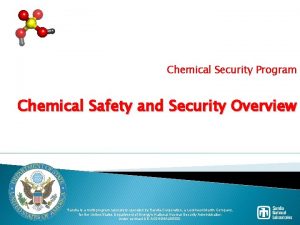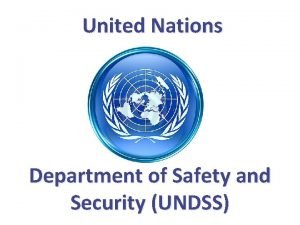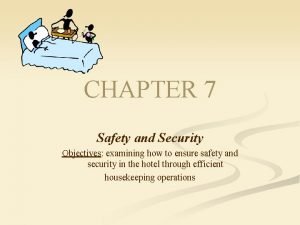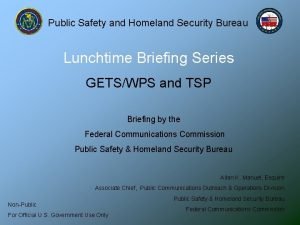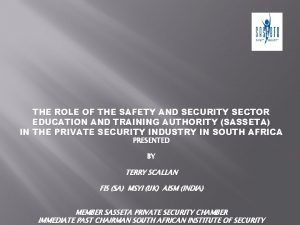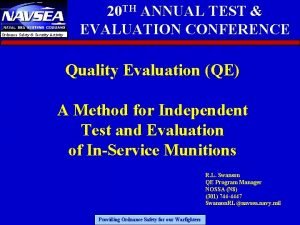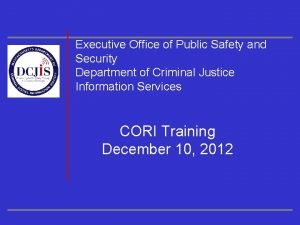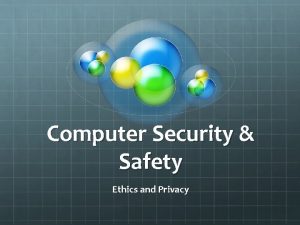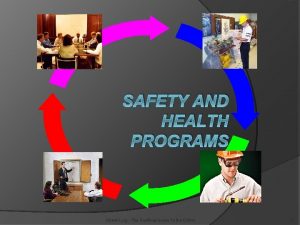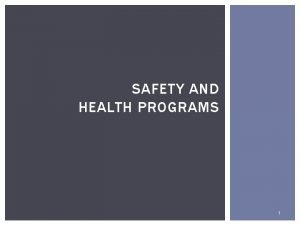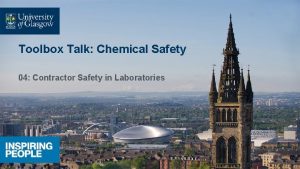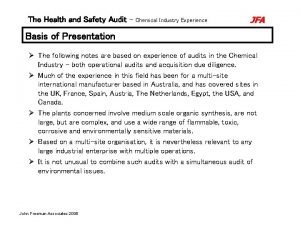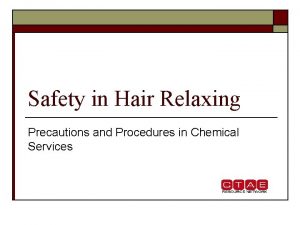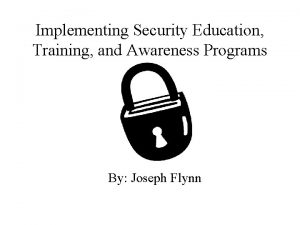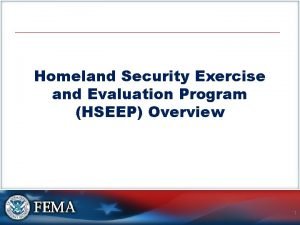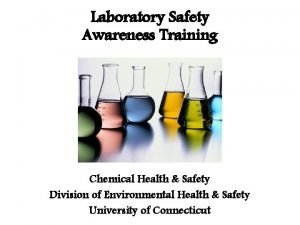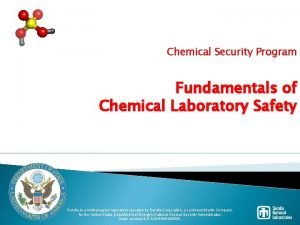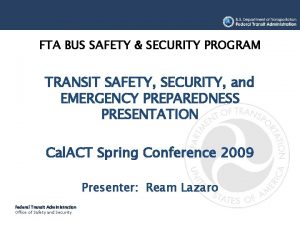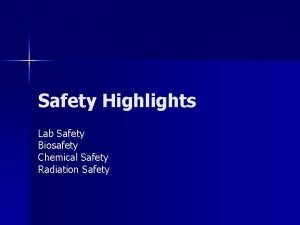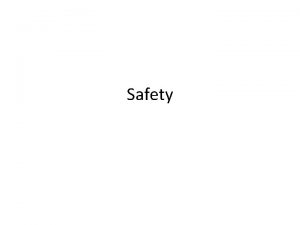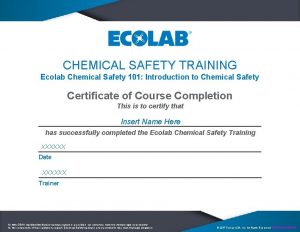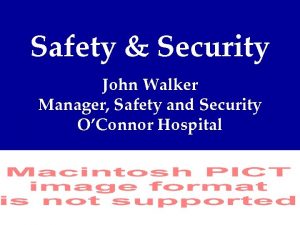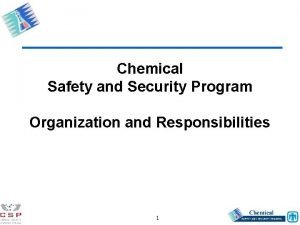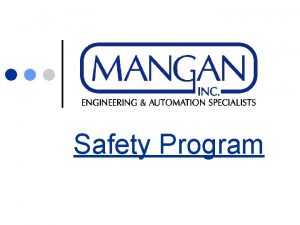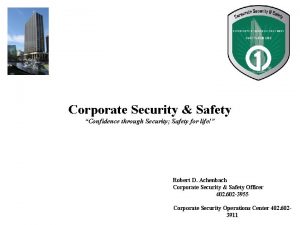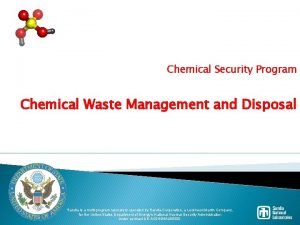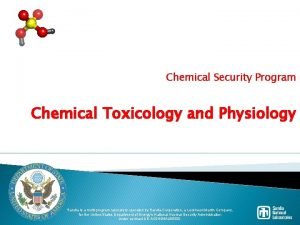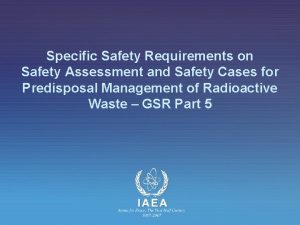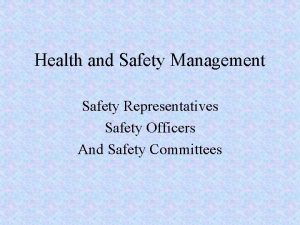Chemical Security Program Chemical Safety and Security Program

















































- Slides: 49

Chemical Security Program Chemical Safety and Security Program: Organization and Responsibilities Sandia is a multi-program laboratory operated by Sandia Corporation, a Lockheed Martin Company, for the United States Department of Energy’s National Nuclear Security Administration under contract DE-AC 04 -94 AL 85000.

Chemical Safety and Security Program: Organization and Responsibilities

Chemical Safety and Security Program Purpose Help establish a safe and secure workplace. � Help safeguard the environment. � Prevent/reduce release of hazardous chemicals and operations. � Prevent/reduce exposure to staff. � Reduce stress. � Enhance community relations. � Comply with regulations. � Crisis management � 3

Crisis Management: Prevention & Response ‣ ‣ Facility crisis • Fire • Explosion • Chemical release Natural disaster • Earthquakes • Hurricane/typhoon • Tsunami ‣ ‣ Disgruntled personnel • Employees • Ex-workers • Students Demonstrations, protests Evacuation / reoccupancy Terrorism 4

Crisis Management: Criminal & Terrorism Concerns ‣ ‣ External security • Fences • Cameras • Guards Internal security • Personnel background checks • Employees, contractors, students � Theft • Chemicals, materials • Equipment � Bombing � Toxic release 5

Chemical Safety and Security Applies to Everyone ‣ ‣ ‣ ‣ ‣ Administration • • Human Resources Purchasing Facilities Construction Police/Security Department Administration Research Administration Employees Students Contractors All visitors 6

Faculty/Principal Investigator ‣ Has the responsibility to teach, model and encourage good Chemical Safety and Security practices 7

Principal Investigator : CSS Responsibilities � � � � Develop procedures with CSSO for unique hazards and chemicals (e. g. carcinogens) Develop proper control practices with CSSO Participate in developing CSS Plan, CSS Committee, accident investigations Ensure CSS documents and records are maintained Maintain local chemical inventory for their lab Ensure (M)SDS are available in the laboratory Facilitate compliance with policies, guidelines and regulations 8

CSS Responsibilities: Principal Investigator � � � Ensure students/workers know and follow policies and practices Ensure equipment and controls are properly maintained Ensure all students/workers received proper training and refreshers Ensure new students/workers receive proper training before starting work Inform CSSO of any accidents and incidents Follow-up on accidents and incidents 9

Employees and Students ‣ Have a responsibility to actively support and participate in the CSS Program. 10

Employee/Student : CSS Responsibilities � � � � � Follow policies/rules Wear Personal Protective Equipment (PPE) Report accidents, incidents/near misses, problems Learn about hazards of specific chemicals Suggest changes and improvements Work safely Do not put others at risk Encourage good safety and security Behave responsibly 11

Employee/Student : CSS Responsibilities � � � � � Understand act in accordance with policies and practices Wear and maintain proper PPE Use engineering controls properly Follow good chemical safety practices Participate in required training Read & understand CSS related documents Report accidents, incidents Suggest improvements and changes to the CSS Program Participate in the CSS Program 12

Chemical Safety and Security Officer ‣ Has the responsibility to provide expertise and information so that a safe and healthy workplace is present 13

CSSO : Training, Experience, Skills ‣ ‣ Chemistry • Nomenclature • Physical properties • Reactivities • Chemical compatibilities Health and Safety (industrial hygiene) Security • Facility • Chemicals • Equipment • Personnel Psychology • Dealing with people ‣ ‣ ‣ Physics • Ventilation • Radiation (ionizing/nonionizing) • Electrical Biology • Biosafety • Recombinant DNA • Blood borne pathogens Administration Writing Speaking/presentations/training 14

CSSO : Responsibilities � � � Report directly to higher management Provide leadership in safety and security Draft a budget Ensure Plans and Manuals are written and updated Advise administration, staff, employees, students Conduct inspections and audits Investigate accidents and incidents Respond to problems and concerns Participate in Chemical Safety and Security Committee(s) Ensure documentation, records and metrics are maintained Develop CSS Training plans Know legal regulations and ensure compliance 15

The Function of the CSSO is to Act as a Co-Worker, NOT as a Policeman 16

Chemical Safety and Security Committee ‣ Has the responsibility to oversee and monitor the CSS Program for management so that a safe and healthy workplace is maintained 17

Chemical Safety and Security Committee : Responsibilities � � � Reports directly to senior management Endorses policies Meets regularly (2 – 4 times/yr) with agendas Reviews accidents and incidents, may investigate, write reports with recommendations Establishes appropriate subcommittees on specific topics 18

Chemical Safety and Security Committee : Composition � Chaired by committed staff � CSSO is ex-officio member � Includes representatives from: • Facilities Management • Security • Administration • Faculty/Staff • Teaching Assistants/Graduate Students • Shops/Unions � Representatives years should rotate after a few 19

Management CSS Responsibilities Commitment: � � � Establish a formal CSS Program Announce formation of a CSS Program Create a written policy statement Designate a Chemical Safety and Security Officer Endorse a written CSS Plan (Manual) Participate and intervene as needed Support: � � Financial support (budget) Staffing Response/resolution of problems by • Establishing a CSS Committee Stipulates CSS is part of everyone's job • CSS applies to everyone • Specifies CSS orientation for new employees � Supports CSS staff 20

Management CSS Responsibilities POLICY STATEMENT Documents and describes the commitment and support from the highest management level for the Chemical Safety and Security Program 21

Policy Statement Purpose ‣ Establish and provide for maintenance of an effective Chemical Safety and Security Program to protect: • • • Employees Facility Neighbors Environment Comply with regulations 22

Policy Statements � � � � By senior management Typically brief Clear goals Commitment Defines employee role Identifies resources and staff Signed by person in authority 23

Director/President CSS Responsibilities � � � � � Establish an effective CSS Program Provide for a budget Endorse written Policies, Plans and Manuals Appoint CSS Officers Ensure CSSO has responsibility, authority and accountability to perform assigned duties Establish a CSS Committee Maintain support and endorsement Timely response to Safety Committee recommendations Follow and set example, e. g. , wears PPE 24

Chemical Safety and Security Program Ideal Roles � � � Culture of Chemical Safety and Security should exist at all levels of the organization. Top management sets policy, provides resources. Workers, students, researchers must understand implement. � Many organizational interactions are important for chemical safety and security • After Fig 1 -1 in Prudent Practices in the Laboratory, NRC 1995 Executive Officer or President Senior Manager Research director, Department chairperson Supervisor Project manager, Principal investigator Laboratory Worker Institutional Safety Officer and Institutional Security Officer Chemical Safety & Security Officer Designated by the department Student, Technician 25

CSS Program Evaluation Management leadership Employee involvement Administrative controls Security controls � � • � � � � Access to buildings, materials Engineering controls Accident/incident investigation Training Use of Personal Protective Equipment (PPE) Emergency Response Program Medical Surveillance Program Work site analysis • Inspections, surveys, hazard analysis 26

Chemical Safety and Security Officer Duties

CSSO Duties Include: Surveys Job Hazard Analysis Inspections Training Medical Monitoring Investigations 28

CSSO Duties � Oversee procurement, use, storage & disposal of hazardous materials � Set criteria for exposure levels � Write and revise CSS Plan � Trains, documents and ensures training is performed � Performs risk assessment and monitoring � Conducts audits and inspections � Investigates and reports on accidents, incidents � Interacts with staff to correct deficiencies � Follows up to ensure correction and resolution of issues 29

CSSO Duties � Consult/advise project management on CSS concerns � Coordinate with Principal Investigators � Coordinate and facilitate medical surveillance � Coordinate record keeping � Coordinate with BSO, RSO, facilities, administration, security 30

Hazard Survey � Baseline � Periodic (inspections) � Identify potential job hazards, material hazards, and process hazards 31

Hazard Survey Process Prepare survey form � Walk-through � Take measurements • Sample if necessary, monitor exposure (e. g. , formaldehyde, radiation) � Data analysis � Write and deliver report � 32

Job Hazard Analysis (JHA) ‣ Hazards associated with a particular task become apparent from a brief survey: • Compile steps needed to complete job. • Analyze each step in detail. ◦ ◦ ◦ Could exposure occur? Could an accident occur? Could a change in practice / process could create hazard? • Develop recommendations on precautions to eliminate/minimize hazard. 33

Periodic Lab Inspections � � � Done by CSSO Coordinate with lab supervisor/Chief/PI/occupants/ safety representative Team may include: • Peers • Facilities representative Frequency determined by hazards present and local practices • 2 - 4 times/yr Look for: • Good and bad practices • new hazards • new security issues 34

Sample Laboratory Survey/Inspection Checklist � � � Date of Inspection: _______ Conducted by: _______ Location (room and building): _______ Principal Investigator/supervisor: _______ Laboratory Work Practices • Smoking observed? • Food observed/stored. In refrigerators? • Mechanical pipetting devices present/used? • Hazardous chemicals present/used in designated areas? • Lab surfaces cleaned/decontaminated after use? • PPE available/properly used, stored, maintained? 35

Survey/Inspection Checklist � Hazard Communication • Warning signs, required PPE posted. • (M)SDS available. • Signs for storage areas, refrigerators, waste, designated work areas’ specific hazards. • Label all containers. • Access controlled. � Personal Protective Equipment • • • Available for each specific hazard. Eye protection available, when & where required & posted. Other PPE available as necessary. Visitor PPE available. Visitor requirements for PPE posted. 36

Survey/Inspection Checklist � Chemical Storage • Area secured • Chemicals with special security needs present? • Chemicals inventoried • Incompatible chemicals segregated. • Volatile, flammable material keep away from heat. • Corrosives, flammables keep below eye level. • Limited quantities of flammables, or other hazardous chemicals, stored in lab. • Unnecessary, outdated chemicals discarded. • Safety carriers available for bottle transport. 37

Survey/Inspection Checklist ‣ Compressed Gas Cylinders • Properly chained or secured • Caps in place, if available • Stored away from heat • Cylinders properly marked with contents • Empty and full separated • Flammables separated from non-flammables • Lines labeled and in good condition • Proper valves used • Toxic gases stored securely 38

Survey/Inspection Checklist � Safety Equipment • Eyewashes & safety showers present, unobstructed, in good working order, routinely tested and maintained. • Fire alarms & telephones appropriately placed and labeled. • Adequate number and type of unobstructed, routinely inspected fire extinguishers. • Spill kits available, maintained, labeled. • Adequate number of fire alarm/ detection devices. • Flammable storage cabinets available. � General Facility • • • Benches are water/chemical heat resistant. Sturdy furniture. Sinks for hand washing. Exits marked Access controls 39

Survey/Inspection Checklist � Ventilation • Hoods available and in good working order. • All hoods marked with properating height and restrictions for use. • Hoods not cluttered with chemical and equipment storage. � Housekeeping • • Lab areas uncluttered. Aisles & exits unobstructed. Work surfaces free from contamination. Spills cleaned up. Electrical cords in good condition, equipment grounded. Heavy objects on lower shelves. Glassware free from defects. 40

Training Program � � � � Determine if training is needed, e. g. , JHA Identify needs Identify Goals & Objectives Develop training activities Identify resources Conduct training Evaluate effectiveness Improve program 41

Employee Training Topics � � � New employee orientation Specialized laboratory equipment and procedures Recognize Occupational Exposure Limits (OEL) for hazardous chemicals; (M)SDS PPE use, storage and maintenance (especially respirators) Fire safety and fire extinguisher use Emergency plans, evacuation procedures & routes Ionizing radiation Non-ionizing radiation, lasers, microwaves Special exposure, e. g. , formaldehyde Biosafety, Bloodborne pathogens Facility security requirements Animal Care facilities - use and techniques 42

Training Documentation : Sample � � � � � Employee name: ______________ Department: _____________ Date: ______ Training Subject: _______________ Training Date: ______ Re-instruction date: _____ Employee Signature: _______________ Date Signed: _____ Supervisor’s signature: _______________ Date: _____ 43

Medical Surveillance Program � Baseline screening • • � Medical history Past illnesses, exposures and diseases Comprehensive physical exam Assessment of limitations ◦ Respirator use and other PPE Treatment • Emergency • Non-emergency (e. g. , first aid) � � � Periodic Medical exam Termination exam Confidential record keeping • Physician, employee 44

Biological Monitoring Program � Identify employees with potential exposure to specific hazardous chemicals, biological agents, working conditions. • • � � � Specific signs and symptoms of chemical exposure. Use of respirators. ◦ Cardiovascular, hearing (perforated tympanic membrane), neurological (e. g. , epilepsy), psychological disorders Working in noisy areas. Working in Biosafety risk areas. ◦ Bloodborne pathogens � e. g. , Human blood and body fluids, hepatitis B (HBV), HIV, AIDS ◦ Infectious agents � e. g. , Zoonosis, animal care, recombinant DNA Determine extent of personal and environmental exposure. Take actions to eliminate/minimize exposure. Confidential record keeping. 45

Medical Surveillance vs. Biological Monitoring Medical Surveillance � � � General program Establishes baseline Evaluates employees before potential exposure Documents past exposure and existing conditions Simpler, cheaper, less invasive medical testing May be used in conjunction with biological monitoring Biological Monitoring � � � Chemical specific signs and symptoms Known exposure levels Documented exposure Documented amounts of personal exposure Documented environmental exposure Most specific, most expensive, more invasive 46

Guidelines for Incident Investigation � � � Description/report of incident Review of organizational policy Start of investigation Cause of incident • Emphasis is prevention, NOT blame • Timely report with recommendations to all responsible parties including senior management Timely response to recommendations • Correction • Follow-up • Action taken • Training 47

Incident Investigation Form: Sample � � � Date of accident/incident_______ Time reported_______ Location____ Type of incident: fire, explosion, spill, employee exposure, theft, intruder, near-miss ____ Date of investigation_____ Investigation team members_________ Nature of Incident � � � Incident description, include people, task, chemicals, etc. involved Nature of injuries, exposures, illnesses, damages, losses Determination of potential causes PPE worn at the time Hazard control or access control measures in use 48

Incident Investigation Form � � Organizational polices, procedures, etc. that apply Was training proper and up-to-date? How could incident been prevented? Has similar incident occurred in past, when, where, circumstances? Team recommendations to prevent reoccurrence of such incidents: ____________________________________________________ 49
 Chemical safety and security
Chemical safety and security Private secruity
Private secruity Chemical security program
Chemical security program Undss security
Undss security Safety and security objectives
Safety and security objectives Cpi care welfare safety security
Cpi care welfare safety security Public safety and homeland security bureau
Public safety and homeland security bureau Law, public safety, corrections and security answer key
Law, public safety, corrections and security answer key 21 setas
21 setas Saudi aramco industrial security
Saudi aramco industrial security Naval ordnance safety and security activity
Naval ordnance safety and security activity Executive office of public safety and security
Executive office of public safety and security Destructive event or prank a virus was created to deliver
Destructive event or prank a virus was created to deliver Where do you activate the four shades function
Where do you activate the four shades function Safety care 2 person stability hold
Safety care 2 person stability hold Personal safety vs process safety
Personal safety vs process safety Safety assessment for ind safety reporting
Safety assessment for ind safety reporting Basic safety construction site safety orientation
Basic safety construction site safety orientation Basic safety orientation
Basic safety orientation Chapter 7 chemical formulas and chemical compounds test
Chapter 7 chemical formulas and chemical compounds test Chemical formulas and chemical compounds chapter 7 review
Chemical formulas and chemical compounds chapter 7 review Security program and policies principles and practices
Security program and policies principles and practices Security program and policies principles and practices
Security program and policies principles and practices Security program and policies principles and practices
Security program and policies principles and practices Security program and policies principles and practices
Security program and policies principles and practices Security program and policies principles and practices
Security program and policies principles and practices Wireless security in cryptography
Wireless security in cryptography Security policy and integrated security in e-commerce
Security policy and integrated security in e-commerce Benefits of a safety and health program
Benefits of a safety and health program Benefits of a safety and health program
Benefits of a safety and health program Develop and implement a food safety program
Develop and implement a food safety program Chemical safety toolbox talk
Chemical safety toolbox talk Chemical safety toolbox talk
Chemical safety toolbox talk Safety audit in chemical industry
Safety audit in chemical industry Olive oil relaxer timing chart
Olive oil relaxer timing chart What is food safety
What is food safety Safety vs security
Safety vs security Chemical reactions section 2 classifying chemical reactions
Chemical reactions section 2 classifying chemical reactions Section 2 classifying chemical reactions
Section 2 classifying chemical reactions Chemical reactions section 1 chemical changes
Chemical reactions section 1 chemical changes Chapter 18 chemical reactions balancing chemical equations
Chapter 18 chemical reactions balancing chemical equations Seta program 5 steps
Seta program 5 steps What is hseep
What is hseep Chemical sensitivity symptoms
Chemical sensitivity symptoms Chemical security analysis center
Chemical security analysis center Osi security architecture in network security
Osi security architecture in network security Guide to network security
Guide to network security Explain about visa international security mode
Explain about visa international security mode Electronic mail security in network security
Electronic mail security in network security Information security
Information security


